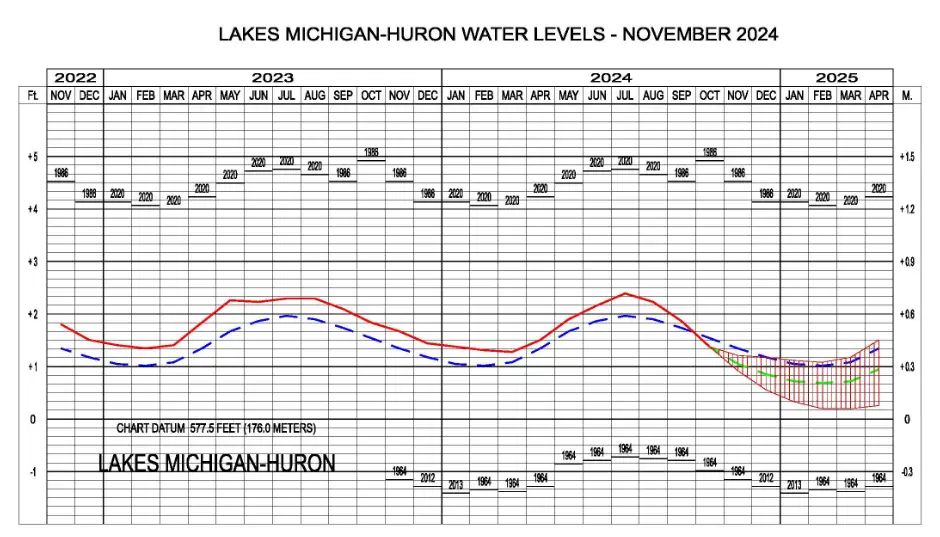Above-average temperatures and two storm systems bring shifting water levels and weather for Michigan and the Great Lakes.
Weather Shifts Impact Great Lakes Water Levels
SAULT STE. MARIE, Michigan – The latest Army Corps of Engineers Weekly Great Lakes Water Level Update, released November 15, 2024, paints a complex picture for the region’s waterways. Following a period of above-normal temperatures from November 8th to 11th, a cold front shifted conditions on November 12th. The Corps’ report details that upcoming weather, including two Colorado-based storms, is expected to further influence precipitation and potential snow accumulation, particularly around Lakes Superior and Michigan.
Water Levels Drop, but Some Lakes Remain Above Average
The November 15th forecast highlights that water levels across the Great Lakes have generally declined compared to last month and last year. Lake Superior, for example, is 2 inches below its October 2024 levels and 7 inches lower than last year at this time. Similarly, Lake Michigan-Huron shows a decrease of 4 inches from October and 8 inches from the previous year. Conversely, Lakes St. Clair and Erie are bucking this trend by remaining 6 and 7 inches above their long-term November averages, respectively.
Long-term projections indicate further declines in water levels by December 15th, with all lakes expected to drop between 1 and 4 inches. This forecasted decrease aligns with historical seasonal trends, though meteorological factors continue to create variability in lake levels.
Lake Superior Outflow Lower, Other Channels Trending Higher
Outflow conditions also reflect a mixed picture for November, with Lake Superior’s outflow into the St. Marys River projected to remain below average, while Lake Michigan-Huron’s outflow through the St. Clair River is slightly above average. Notably, Lake Erie and Lake Ontario are experiencing increased outflows via the Niagara and St. Lawrence Rivers, respectively. The Corps’ alert emphasizes that meteorological influences can significantly impact water levels, necessitating caution for those using and navigating these waterways.
Historical Context and Navigational Alerts
As the Great Lakes experience this ongoing transition, water levels remain well below record highs but vary significantly from their long-term averages. Lake Michigan-Huron, for instance, stands 42 inches below its November record high from 1986, but remains 26 inches above the lowest recorded monthly mean from 1964. These fluctuations underscore the critical role of accurate monitoring and weather forecasting for both local residents and industries reliant on these vital water channels.
With changing water levels, mariners are urged to consult navigation charts and current readings. The Corps stresses that still-water surface elevations can differ locally due to weather conditions and users of the Great Lakes should remain vigilant.
Find More Interesting Feature Stories From ThumbWind Publications
“Michigan Stories” – Unveiling the people, places, and events that make the Great Lake State unique, we’ll explore hidden gems and must-do activities.
“Weird Political News” – A sarcastic and insightful take on official news released by government sources, Political Action Committees and Public Officials from all over the US. All stories are true and sourced.
“ThumbWind News” – News and events of Michigan’s Upper Thumb that are worth knowing in the region.
Your Turn – Like This, or Hate it – We Want To Hear From You
Please offer an insightful and thoughtful comment. Idiotic, profane, or threatening comments are removed. Consider sharing this story. Follow us to have other feature stories fill up your Newsbreak feed from ThumbWind Publications.




